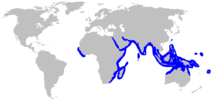Hedgehog rays
| Hedgehog rays | ||||||||||||
|---|---|---|---|---|---|---|---|---|---|---|---|---|

Hedgehog rays ( Urogymnus asperrimus ) |
||||||||||||
| Systematics | ||||||||||||
|
||||||||||||
| Scientific name | ||||||||||||
| Urogymnus asperrimus | ||||||||||||
| ( Bloch & Schneider , 1801) |
The hedgehog ray ( Urogymnus asperrimus ) is a heavily armored stingray that is widespread in tropical seas .
features
Hedgehog rays are on average 1.2 to 1.4 meters wide, rarer specimens up to 2.2 meters wide. The body disc is very thick, built higher than most other ray species and almost round. The body surface of young hedgehog rays is covered with flat skin teeth, the larger young rays and the fully grown specimens with sharp, conical thorns and smaller, pointed skin teeth. The thorns can cause painful injuries. The tail is slender and just as long as the body disc. There are no fins on the tail and a poison sting at the base of the tail, a typical feature of the other stingrays. The back of the hedgehog rays is gray or whitish, the tail darker and the belly white. Hedgehog rays have 48 flattened teeth in both the upper and lower jaw.
Way of life and distribution
Hedgehog rays live in the coastal regions down to depths of 30 meters. They are relatively rare. Preferred habitats are sandy or coral break-covered areas in lagoons or near coral reefs. They also quite often hide in caves or rest buried in the sand. Hedgehog rays feed mainly on crustaceans and smaller fish. Like all stingrays, the hedgehog ray is ovoviviparous and gives birth to up to 12 young rays per litter. Females as well as males reach sexual maturity from a size of 90-100 cm.
The hedgehog rays are found in the Red Sea and the Indo-Pacific from the coast of East Africa to Australia , Fiji and the Marshall Islands . There is also a population in the tropical east Atlantic from the coast of Senegal to the Ivory Coast .
Systematics
The hedgehog rays were first described in 1801 by the German naturalists Marcus Elieser Bloch and Johann Gottlieb Schneider . Both discovered for the first time only the skin of the rays on their journey through Mumbai and gave the species the name Raja asperrima (asperrima = Latin: roughest) due to the robust skin of the animals. The addition Urogymnura comes from Johannes Peter Müller and Friedrich Gustav Jakob Henle . The Greek words “oura” stand for “tail” and “gymnos” for “naked, disarmed”, which indicates the lack of poisonous sting that stingrays usually have.
threat
According to the IUCN , hedgehog rays are classified as endangered. Hedgehog rays often die as unwanted bycatch in drift nets as well as trawls. In the Bay of Bengal, as well as in the Gulf of Thailand , the animals are already locally extinct. Overfishing in these areas is also a problem for the rays. On the Farasan Islands in the Red Sea , the liver of the hedgehog rays is considered a delicacy and consumed.
The particularly rough skin of the rays ensures that they are hunted commercially to make leather from their skin. This leather was even used to cover sword holders and shields, as the skin makes these combat objects particularly robust.
literature
- Hans A. Baensch / Robert A. Patzner: Mergus Sea Water Atlas Volume 7 Perciformes (perch-like) , Mergus-Verlag, Melle, 1998, ISBN 3-88244-107-0
- Dieter Eichler / Robert F. Myers: Korallenfische Indopazifik , Jahr-Verlag GmbH & Co., 1997, ISBN 3-86132-225-0
Web links
- Hedgehog rays on Fishbase.org (English)
- Urogymnus asperrimus inthe IUCN Red List of Threatened Species 2013.1. Posted by: Compagno, LJV, 2005. Retrieved November 3, 2013.
